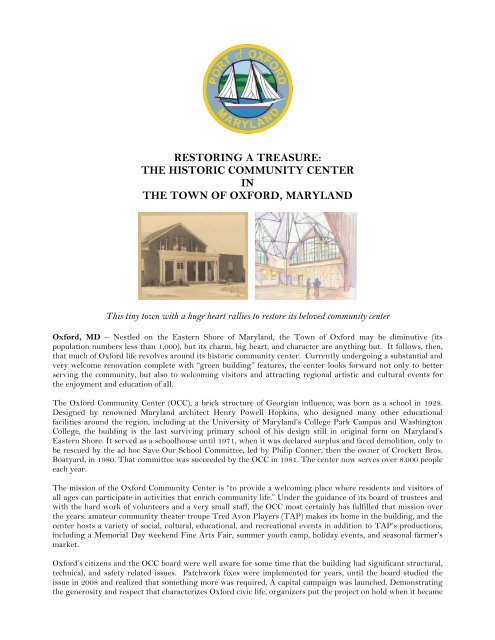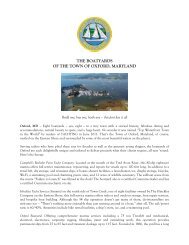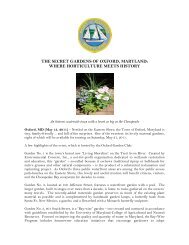Oxford Community Center - Oxford Business Association
Oxford Community Center - Oxford Business Association
Oxford Community Center - Oxford Business Association
Create successful ePaper yourself
Turn your PDF publications into a flip-book with our unique Google optimized e-Paper software.
RESTORING A TREASURE:<br />
THE HISTORIC COMMUNITY CENTER<br />
IN<br />
THE TOWN OF OXFORD, MARYLAND<br />
This tiny town with a huge heart rallies to restore its beloved community center<br />
<strong>Oxford</strong>, MD – Nestled on the Eastern Shore of Maryland, the Town of <strong>Oxford</strong> may be diminutive (its<br />
population numbers less than 1,000), but its charm, big heart, and character are anything but. It follows, then,<br />
that much of <strong>Oxford</strong> life revolves around its historic community center. Currently undergoing a substantial and<br />
very welcome renovation complete with “green building” features, the center looks forward not only to better<br />
serving the community, but also to welcoming visitors and attracting regional artistic and cultural events for<br />
the enjoyment and education of all.<br />
The <strong>Oxford</strong> <strong>Community</strong> <strong>Center</strong> (OCC), a brick structure of Georgian influence, was born as a school in 1928.<br />
Designed by renowned Maryland architect Henry Powell Hopkins, who designed many other educational<br />
facilities around the region, including at the University of Maryland’s College Park Campus and Washington<br />
College, the building is the last surviving primary school of his design still in original form on Maryland’s<br />
Eastern Shore. It served as a schoolhouse until 1971, when it was declared surplus and faced demolition, only to<br />
be rescued by the ad hoc Save Our School Committee, led by Philip Conner, then the owner of Crockett Bros.<br />
Boatyard, in 1980. That committee was succeeded by the OCC in 1981. The center now serves over 8.000 people<br />
each year.<br />
The mission of the <strong>Oxford</strong> <strong>Community</strong> <strong>Center</strong> is “to provide a welcoming place where residents and visitors of<br />
all ages can participate in activities that enrich community life.” Under the guidance of its board of trustees and<br />
with the hard work of volunteers and a very small staff, the OCC most certainly has fulfilled that mission over<br />
the years: amateur community theater troupe Tred Avon Players (TAP) makes its home in the building, and the<br />
center hosts a variety of social, cultural, educational, and recreational events in addition to TAP’s productions,<br />
including a Memorial Day weekend Fine Arts Fair, summer youth camp, holiday events, and seasonal farmer’s<br />
market.<br />
<strong>Oxford</strong>’s citizens and the OCC board were well aware for some time that the building had significant structural,<br />
technical, and safety related issues. Patchwork fixes were implemented for years, until the board studied the<br />
issue in 2008 and realized that something more was required. A capital campaign was launched. Demonstrating<br />
the generosity and respect that characterizes <strong>Oxford</strong> civic life, organizers put the project on hold when it became
apparent that the <strong>Oxford</strong> Volunteer Fire Company needed new housing even more desperately. The delay<br />
proved fortuitous, however, as it gave the board some extra time and distance to create a more robust and longrange<br />
vision for the building and its future role in the community and the region. Finally, on August 16, 2010,<br />
the OCC launched it capital campaign.<br />
The board was delighted to find the ideal architect for the project in <strong>Oxford</strong> resident Cameron Mactavish, a<br />
partner in Voith & Mactavish, a firm widely recognized for its historical renovation work. As Mr. Mactavish<br />
describes it, “The community center is a testament to the rich heritage of the Eastern Shore. It has an<br />
architectural ancestry that is descended from Ancient Rome and the Baths of Caracalla, filtered through New<br />
York Penn Station and distilled in Baltimore by Henry Hopkins. For the last decade I have observed<br />
this historic building and admired its good bones and fine proportions. It is to become a great glowing lantern,<br />
or a set piece, for the Town, illuminated within by the energy and light of the community of <strong>Oxford</strong>.”<br />
His vision helped make the $2.5 million project a resounding success, but not without unflagging effort on the<br />
part of many, including Senator Richard R. Colburn, who attended school in the building and was one of the<br />
honorary chairs of the campaign committee. Fueled by the efforts of that committee, the initiative is close to<br />
achieve its funding goal. (Check out the goose and the golden egg in front of the center.) Notably, donations,<br />
pledges, and grants were made not only by the State of Maryland (including $625,000 provided pursuant to the<br />
Sustainable Communities Tax Credit program); the Town; citizens; part-time residents; visitors; and several<br />
private foundations – and each and every member of the board and staff of the OCC. And the project created<br />
approximately 46 jobs!<br />
The all-volunteer board, along with staff and volunteers, worked long and hard to find a way to restore the<br />
historic façade while bringing the interior of the building into the 21st century and retaining its original charm<br />
and openness. Representatives of each group that use the center – young and old, artists and musicians, visitors<br />
and residents – were consulted for ideas to create the best possible design.<br />
As designed, the building now includes a raft of environmentally sustainable features – not only new windows<br />
and HVAC systems, which save energy and reduce operating costs, but also high efficiency lighting and<br />
geothermal heat and cooling. Geothermal heat pumps can help reduce consumption of energy the emissions that<br />
traditional HVAC systems produce by up to 40% compared to air source heat pumps and by over 70% compared<br />
to electric resistance heating with standard air conditioning systems. And, instead of allowing roof runoff to<br />
make its way to the Chesapeake Bay, the building will channel it into rain barrels and use it to water the<br />
landscape. (Speaking of the landscape, restoration and improvement of that vital feature will be undertaken by<br />
the <strong>Oxford</strong> Garden Club.) And, of course, the very fact that the building is being renovated rather than replaced<br />
is a sustainable feature. Indeed, the OCC intends to seek certification by the United States Green Building<br />
Council as a LEED-qualifying building. (“LEED” stands for Leadership in Energy and Environmental Design.)<br />
The facility will also be kid friendly, with wall finishes selected not just for their ability to enhance the quality of<br />
the listening and performing experiences but also the ability to create hanging displays for kids’ creative<br />
handiwork, as well as custom-designed sinks, computer furniture, and other features in the new OK Kids Camp<br />
& Afterschool Classroom. Speaking of the walls, Bob Dietz – the Building Restoration Committee Chair without<br />
whose herculean efforts this project would not be such a triumph – is fond of showing visitors the graffiti (Grated!)<br />
found on the walls when the bulletin boards were removed from various rooms. Written on one old<br />
plaster swatch was the name of the company that, research revealed, had indeed installed the building’s original<br />
plasterwork. In another room was a lovely line sketch of a mystery lady.<br />
When it re-opens its doors to the public in early 2012, the reborn <strong>Oxford</strong> <strong>Community</strong> <strong>Center</strong> once again will<br />
touch people’s lives by serving as a place for:<br />
• Enjoying cultural and performing arts, with a raised ceiling, exposed original steel trusses (covered up<br />
in the 1960s), and restored lunette windows (formerly boarded up) creating a light-filled atrium and<br />
new seating, lights, and sound system<br />
• Celebrating life’s major events, with a new hospitality room opening into the atrium and the new patio<br />
that will serve as a venue for parties and other large gatherings<br />
Page 2 of 3<br />
<strong>Oxford</strong> <strong>Community</strong> <strong>Center</strong>
• Welcoming visitors, with a moveable shelving divider that creates a new space in a renovated classroom<br />
to greet visitors and provide information<br />
• Holding meetings and workshops, with two renovated classrooms equipped with updated technology<br />
such as wi-fi, enhanced sound, and a projection screen<br />
• Engaging the accessibility challenged, with a new ramp at the front of the building, heated sidewalks<br />
and steps at the entrance, an accessible family restroom with a private entrance, technology to link<br />
hearing aids with the sound system -- and even an elevator providing access to the backstage area<br />
• Respecting the environment, with a variety of sustainable building features<br />
• Learning and growing, with updates and enhancements in each classroom to facilitate a wider variety of<br />
programs for students of all ages.<br />
“We are incredibly fortunate, and so grateful to our visionary founders for saving the building,” states Barbara<br />
Seese, executive director of the center. “The <strong>Oxford</strong> <strong>Community</strong> <strong>Center</strong> serves as a cornerstone to our<br />
community – with many, many memories made here over the years. We’re a great example of what can happen<br />
when people share a vision and work together to make a difference.” Board president Bill Ritchie agrees, saying,<br />
“The support we are seeing from private citizens, our public officials, and the State of Maryland speaks to a<br />
strong shared belief in this project and the importance of community.”<br />
Visitors are warmly welcomed to come on over and experience tiny-but-terrific <strong>Oxford</strong>, Maryland as it<br />
celebrates the grand re-opening of the OCC. Stayed tuned for details! (A tantalizing possibility: the original<br />
architect’s grandson Hoppy, who spoke at the campaign kickoff and happens to play in a band, may appear in<br />
concert with his band mates.)<br />
The Town of <strong>Oxford</strong>, Maryland: docks, daydreams, discoveries, and so much more<br />
About <strong>Oxford</strong>, Maryland:<br />
The historic town of <strong>Oxford</strong>, Maryland, founded in 1683, is located in Talbot County on the Eastern Shore of<br />
the Chesapeake Bay. Until the American Revolution, <strong>Oxford</strong> was an international shipping center, surrounded<br />
by tobacco plantations and home to a number of prominent national figures. Later it thrived on oyster<br />
harvesting and packing and other watermen’s trades, even as tourism and leisure activities increased. It guards<br />
its peaceful personality, architectural integrity, and small-town virtues to this day, while warmly welcoming<br />
visitors from right next door and around the world. The <strong>Oxford</strong> <strong>Business</strong> <strong>Association</strong> welcomes inquiries by<br />
telephone (1-410-745-9023) and at its website (www.portofoxford.com); and the Talbot County Office of<br />
Tourism offers comprehensive information and trip planning services at its Easton office (1-410-770-8000) and<br />
on its website (www.tourtalbot.org).<br />
PRESS INFORMATION<br />
Carlyle Fairfax Smith<br />
Carlyle International<br />
Ph: 703.898.1333<br />
Carlyle@CarlyleInternational.us<br />
October 2011<br />
Page 3 of 3<br />
<strong>Oxford</strong> <strong>Community</strong> <strong>Center</strong>






